Choosing a Home Heating System: Comparing The Best Home Heating Systems for the Northeast
Sep 18, 2019
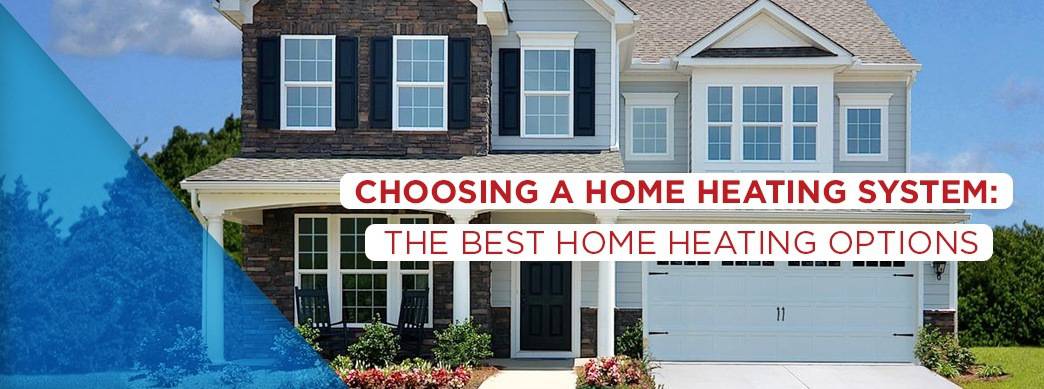
Whereas people once had to rely on wood or coal to heat their homes, modern homeowners can choose from a broader variety of heating fuels. In this article, we’ll cover the most common heating sources for your home and examine the benefits of each one. By the time you’re finished reading, you’ll be able to make a well-informed decision about which is the best heating system for your home.
Average Winter Weather in Central Pennsylvania
If you’ve lived in Central Pennsylvania for a while, you probably noticed that the winters are not exactly balmy. While average temperatures in the Southern part of the state hover around 30s and 40s, January lows often dip into the teens, and some areas receive over 30 inches of snow per year. So what’s the best heating system for a house in the Northeast?
- Natural gas: In terms of heating efficiency, natural gas is the quick answer. Depending on your location, Pennsylvania can bring long and harsh winters, so gas furnaces are often recommended because they can heat up the home relatively quickly, and hotter air can be delivered to the entire house without putting too much stress on the system. Switching from oil to gas is easier then you’d think too. However, fuel costs should also be taken into consideration, as natural gas in Pennsylvania is more costly than the national average. Although some speculate that the cost could rise, the price has gone down the past few years thanks to technological developments. Pennsylvania residents actually saved over $30 billion in their natural gas costs over the past decade.
- Electricity: The cost of electricity in Pennsylvania is around the national average, although prices in the state have risen by 3 percent in just the past year.
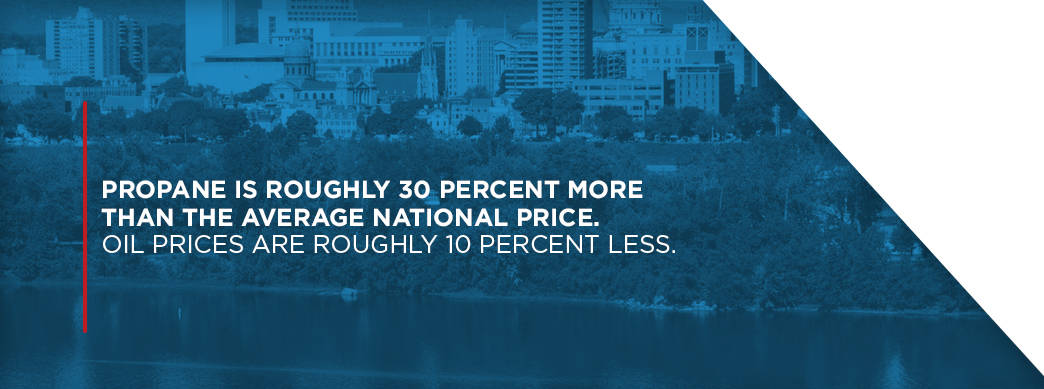
- LP gas or oil: LP (liquid petroleum) gas and oil are also options to consider in Central Pennsylvania. In terms of cost, however, propane is roughly 30 percent more than the average national price. Oil prices, on the other hand, are roughly 10 percent less. Almost a quarter of homeowners in the Northeast have oil furnaces, which is a higher rate than any other U.S. region.
Home Heating Options for Your Pennsylvania Home
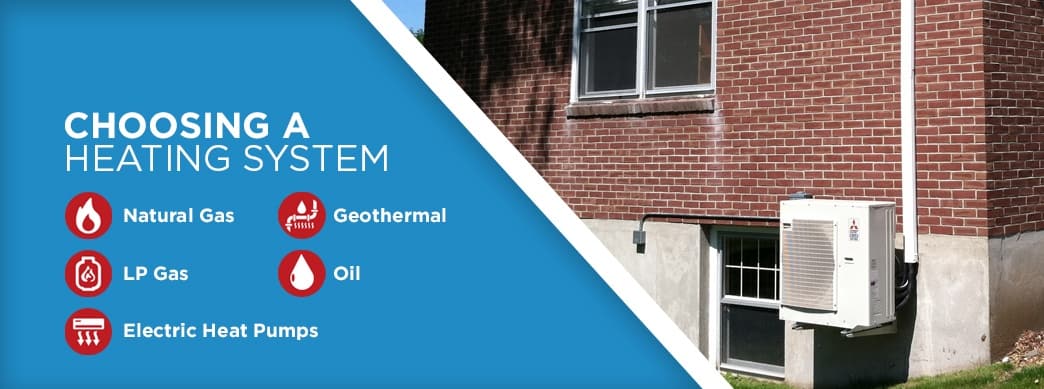
There are various types of home heating methods used in the United States. Below we’ll explain how each type of heating system works:
1. How Natural Gas Heat Works
Natural gas is the most common home heating fuel. The U.S. Department of Energy reports that natural gas is used in about 57 percent of all U.S. homes. While its use in the U.S. is declining everywhere except the Northeast, natural gas home heating systems are still by far the favorite choice in every region of the country with the exception of the South, which relies mainly on electricity.
In natural gas furnaces, heat is generated by a pilot light that ignites several burners in a combustion chamber. This heat then travels to a heat exchanger, at which point the heat is transferred to the air and raises that air to the temperature on the thermostat. Then, blowers send the air through the ducts and deliver it to the rest of the house.
Learn more about Converting to Gas
2. How LP Gas Heats Homes
Liquefied petroleum gas (LP gas or LPG) is an alternative to natural gas and provides about 3% of all energy consumed. LPG is a flammable mixture of different gases and consists of either propane or butane. For reference, propane and butane are both hydrocarbons and have been used in the home since at least 1912. When liquefied, they can be transported, stored and used as a source of convenient energy.
LPG heating systems can work with convective fan-driven heaters, with radiant floor systems or a combination of both. Typically, LPG systems can be tailored to heat an entire home area or be applied to targeted rooms. This helps increase the efficiency of LPG.
LPG is a safe alternative home heating method and is often mistakenly thought of as a leading cause of home fires. However, the National Fire Protection Association doesn’t list LPG as a leading cause or contributor to home fires. More than 14 million American homes use LPG, although it’s one of the least common consumer choices.
3. How Electric Heat Pumps Work
Heat pumps work as follows — they start with a compressor and two copper coils, one of which is indoors while the other is outside. When heating, the outside coil takes heat out of the air via a liquid refrigerant that evaporates and the indoor coil releases heat from the refrigerant by condensing it back to a liquid state. The process can be reversed to cool the indoors.
Many years ago, heat pumps weren’t particularly efficient. New technological advances, however, have improved their efficiency by as much as 100 percent. You can see just how efficient the heat pump is by looking at the EnergyGuide label.
On the label, heating is measured in terms of a heating season performance factor (HSPF). This is expressed as the ratio of British thermal units (BTUs) needed to heat a volume of air to the electrical energy (watt-hours) needed to drive the heat pump.
Cooling is measured similarly by what’s called the seasonal energy efficiency ratio (SEER). It’s the ratio of the BTUs needed to cool — that is, remove heat from — a volume of air to the total watt-hours needed to drive the pump that does the work.
You should look for efficient electric heating systems with HSPFs in the range of 8 to 10 and SEERs in the range of 14 to 18. Even if you can’t find a pump that efficient, you have to consider the equipment you are replacing. Pumps from the 1970s might have a SEER of about 6, so stepping up to a SEER of 12 means you’re going to use only half the electricity that you did before.
4. How Geothermal Systems Heat
Generally, geothermal HVAC systems work by circulating fluid through tubes and serve as both a furnace and an air conditioner. When acting as a heater, the liquid absorbs heat from the ground and delivers it to the house, where the heat gets distributed using a hydronic or forced-air system. When acting as an air conditioner, the process is reversed: the liquid absorbs heat from inside the house and puts it back in the ground.
Geothermal systems have three components — a heat pump, a heat exchange system and a delivery system. The delivery system is either an air duct system or radiant heat, typically in the floor of the home.
This system is much more efficient than conventional systems because it doesn’t involve burning fuel to generate heat — it just transfers existing heat from one location to another. Because temperatures underground stay a fairly constant 50 degrees all year long, much less energy is required for cooling your home than conventional air conditioning systems or air-source heat pumps.
Learn more about Geothermal Installs
5. How Oil Heats Your Home
Home heating-oil systems work by burning what’s called No. 2 heating oil. The fuel is drawn from a storage tank by a pump. The fuel next goes through a fine spray nozzle where it mixes with air and is ignited. The heat from the combustion chamber is then used to warm up air or surrounding water/steam for use in the home.
No. 2 heating oil is a mixture of hydrocarbons that is much heavier than alternatives such as natural gas or propane. In the U.S., it’s transported by tanker trucks and stored in large above-ground tanks.
A gallon of No. 2 delivers 138,000 BTUs of energy, which is more than you get from a gallon of propane or butane, which average about 91,000 to 102,000 BTUs. This is one reason people focus on heating oil as a potential choice.
Benefits of Each Heating System
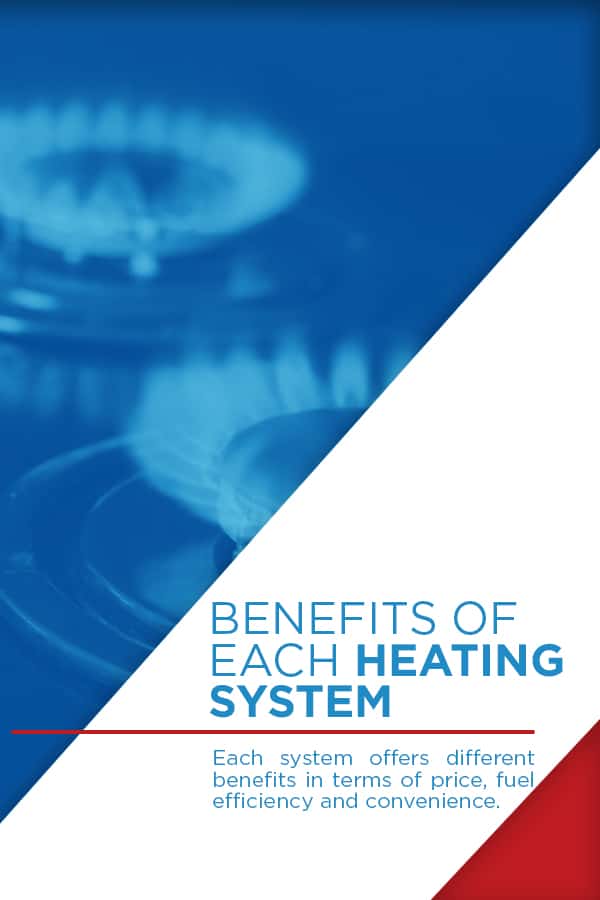
Each system offers different benefits in terms of price, fuel efficiency and convenience. Below we’ll cover the advantages of each one:
1. Benefits of Natural Gas Heat
Natural gas is the most popular heating option in the United States, and the reasons are many:
- It’s piped directly into your house. Your home can be directly connected to a natural gas line, so you’ll never run out. This also means that you won’t need to make room for a gas tank.
- It’s powerful. Natural gas can heat homes in most cold climates.
- It heats more quickly than electricity. For example, you can replace the hot water you use in a 10-minute shower about 60 percent faster with a heater that relies on natural gas rather than electricity.
- It’s the cleanest fossil fuel. Natural gas emits half the amount of CO2 that oil-fired heating does.
- It’s highly efficient. This is especially true if you use a modern condensing boiler.
- Easily controllable. You can instantly turn it off and on.
- Comparing prices is easy. If you’re considering switching suppliers, you can easily compare prices.
- Finding service technicians is easy. If something goes wrong, it’s not hard to find someone to repair your system.
2. Benefits of LP Gas Heat
LPG is most commonly used for camping and caravanning, but it can also be an option if you can’t get natural gas. In fact, some systems designed for natural gas can be converted to use LPG.
The liquid gas is delivered into a tank or in refillable bottles. Some benefits of LP gas include:
- It has many uses. It can be used for central heating, gas fires and cookers.
- It’s convenient. Propane can be delivered right to your doorstep. It’s also widely and readily available, with 56,000 miles of pipeline and over 6,000 retail dealer locations around the United States.
- It’s environmentally friendly. It creates lower carbon emissions than heating oil. When propane is burned, it easily meets the EPA’s clean air standards.
- It’s safe. Thanks largely to the strict codes established by the propane industry and the National Fire Protection Association (NFPA), propane has an excellent safety record. Of course, as is the case with any energy source, there are still precautions that homeowners should take to ensure their safety.
- Its price is more stable. Because 90 percent of the propane consumed in this country is also produced here — with the remaining supply coming from Canada and Mexico — propane is less affected by the price instability of international politics.
- Propane tanks last a long time. Propane tanks can have a lifespan up to 40 years and require little maintenance.
3. Benefits of Electric Heat Pumps
One of the greatest benefits of electric heat pumps is their availability. If you have electricity, then electrical heaters are an option. Some other benefits of electric heat pumps are:
- They’re safe. Electric heat pumps are considered safer to operate than combustion-based systems.
- They’re eco-friendly. Heat pumps convert energy to heat with a high rate of efficiency, meaning that carbon emissions are low. Systems such as furnaces, on the other hand, are known to pollute more.
- They provide cooling as well. During the warmer months of the year, heat pumps can also serve as air conditioners.
- They don’t produce dry air. This means you won’t have to use a humidifier to deal with the dry air, which is a common issue with furnaces.
- They provide uniform heating. With electric heat pumps, you won’t feel temperature fluctuations as much across your home, which is a problem associated with some other heating systems.
- They’re quiet. Electric pumps do not make much noise, and the fact that the air compressor is typically outside your house also helps to keep the noise levels down. Other types of heat pumps may produce a lot of noise.
In warmer regions where winters are less harsh, an electric heat pump can be a great choice. It can deliver more heat energy to your home than the electrical energy it requires.
4. Benefits of Geothermal Heat
A geothermal HVAC system for the home offers several advantages. One important advantage is that the system is generally underground, out of sight, and maybe out of mind too. Some other advantages of geothermal systems include:
- They’re eco-friendly. Geothermal heating systems use the sun — a clean, renewable resource — for energy. Because no combustion is involved, this means that no carbon dioxide, carbon monoxide or other harmful gases are emitted. This also means there is no risk of harmful combustion-related gases in your home. If your primary concern is carbon emissions, you should give some thought to getting a geothermal system.
- They’re efficient. Temperatures above ground can vary greatly, but temperatures below ground are much more consistent. This helps the efficiency of the system and results in less energy used.
- They’re quiet. Geothermal heating systems have no noisy outdoor compressors or fans, and the indoor unit is typically no louder than a refrigerator.
- They evenly cool your home. While more conventional heating systems tend to produce blasts of hot or cold air that can be uncomfortable, geothermal systems heat homes evenly.
Learn more about Geothermal Installs
5. Benefits of Oil Heat
Heating your home with oil also offers several advantages:
- It can be the most cost-effective option. If you live in a rural area where natural gas is not available, heating with oil is often the most economical option.
- It has other applications. While most appropriate for boilers, you can also use oil for some cookers.
- It’s controllable. You can control oil easily, so it provides heat when it’s needed.
- It’s highly efficient. Oil is a very efficient fuel, giving off a good amount of heat for the energy spent.
- It should never run out. Provided that you regularly monitor how much fuel is in your tank and get your next delivery ordered in time, you should never be without fuel.
- Flexible payment may be possible. A flexible supplier may allow you to spread the payments over several months, making it easier to budget your monthly expenses.
- You can change your supplier. If you become unsatisfied with a supplier or the price or their oil, then you can just pick a different supplier for the next delivery.
Average Heating Costs of Each System

In this section, we will give you a rough idea of what you can expect to pay with each heating system.
1. Natural Gas Heating Costs
Because natural gas is competitively priced, it’s typically the most economical option.
The annual costs of natural gas are significantly better than propane or oil. In general, the cost of natural gas has been between 50 to 80 percent of the cost of equivalent energy units of propane or heating oil.
The efficiency of a natural gas system is measured by its annual fuel utilization efficiency (AFUE). AFUE measures the amount of energy going into the HVAC system and the amount of energy that comes out as usable heat. The measure is constructed so that the higher the AFUE, the better.
Modern natural gas systems have AFUE ratings between 78 and 97 percent, making them a particularly efficient way to heat your home. You can do a cost analysis by examining how much the system costs to purchase as well as the expected annual operating cost. For example, a system with an AFUE of 78 might cost $500 less than one with an AFUE of 97, but it might use more than $130 per year beyond the 97-rated system. If you plan on keeping your home for several years, the cost trade-off can favor the higher-efficiency system.
2. LP Gas Heating Costs
If you want to get an idea of how much it costs to operate a propane furnace, follow these steps:
- Find out the current price per gallon of domestic propane.
- Multiply this cost by 1 million BTUs, then divide the resulting number by 91,333 BTUs, which is the number of BTUs in one gallon of propane.
- Divide the resulting number by your furnace’s efficiency.
For instance, if the average cost per gallon is $2.40 and your furnace is 78 percent efficient, then that means that 1 million BTUs would cost roughly $33.67. Considering that homes in the United States require on average 50 to 150 million BTUs per year, if you live in a milder climate, you could expect to spend around $1,684 on propane annually.
3. Electric Heat Pump Heating Costs
The average annual cost for operating a heat pump is around $500, while this will vary depending on the size of your home and your location, it may cost significantly less to run than heating systems that run on combustion like gas and oil. The more energy efficient the system is, the greater the long-term energy savings will be.
4. Geothermal Heating Costs
Geothermal heating systems are by far the least expensive systems to operate, costing an average of $259 per year. Compared to conventional heating systems, you’ll be saving 30 to 60 percent by going with this heating system.
5. Oil Heating Costs
The average yearly cost of operating an oil-fueled furnace is $820. Oil-fueled heating systems have also become more efficient over time, with some systems exceeding 90 percent efficiency, but the cost of heating oil has also increased in recent years.
The U.S Department of Energy reports that the price in dollars per gallon for home heating oil has increased from less than $1 per gallon in 1995 to more than $3 per gallon now, which is relatively expensive compared to natural gas for the same BTU output.
Average Installation Costs for Each Heating System
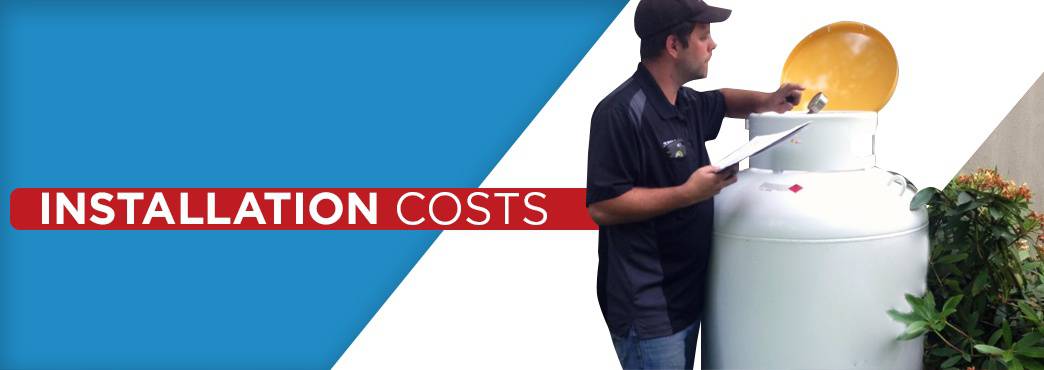
The installation cost of a heating system depends on a variety of factors, including the size and efficiency of the unit and your home’s ability to accommodate the system.
1. Natural Gas Installation Costs
The cost of installation for a natural gas system depends on where you live, and you also have to include the cost of the appliances that will be running on the gas line. A gas line can cost from $1,500 to $3,000, but conversions from oil and new installations can range from $2,000 to $9,000 or more.
Moving to a natural gas-based home heat and water system can capture rebates from federal and state government programs. That helps make up for the extra costs of appliances and conversions.
2. LP Gas Installation Costs
Installing a propane furnace costs an average of $3,000 to $5,000 for a 2,000-square foot home. The furnace itself ranges from $800 to $2,000, with more efficient furnaces costing more. The labor costs tend to be between $1,000 and $2,000, and if you need to take out an existing furnace, the cost of disposing of it could add another $600 to $1,000.
3. Electric Heat Pump Installation Costs
The cost of installing a three-ton electric heat pump system, which is the size most suitable for an average-sized home, ranges from $2,000 to $8,000. If new ductwork needs to be installed or replaced, the cost can be anywhere from $4,000 to $24,000. If adding ductwork is out of your budget, ductless mini-split systems are a more affordable alternative, with costs typically ranging between $2,000 and $7,000, depending on how many units or zones are installed.
4. Geothermal Installation Costs
Geothermal HVACs are an excellent choice for green-minded consumers. They emit no greenhouse gases and are often very quiet. However, as with many eco-friendly products, geothermal HVACs are going to be more expensive than other options. They can cost twice as much or more than a conventional system, but you can look for governmental subsidies that can make the costs very competitive.
The cost of a geothermal system is estimated based on the indoor and underground installation costs, which often depend on the conditions of your soil, the size of your lot, the accessibility of the site and how much drilling and digging is needed. If this installation is a retrofit, modification to your ductwork may also be required.
These costs can exceed $15,000, even with federal tax credits. After that initial outlay, however, you save dramatically — there are no more LPG or other fossil fuel costs and your savings can be on the order of $2,800 annually. In the long-run, the cost savings by going geothermal can be truly substantial.
Recovering these installation costs with energy savings, however, could take anywhere from four to 15 years. Do some research and get some professional opinions to figure out whether installing a geothermal system makes sense for you financially.
5. Oil Installation Costs
If your home is around 2,000 square feet, you can expect to pay anywhere from $3,000 to $5,000 to install an oil-fueled heating system. The furnace itself costs between $500 and $2500, depending on its size and efficiency. The labor tends to cost around $1,000 to $1,500, and if an existing furnace needs to be removed, you can expect to pay an additional $600 to $1,000.
Life Expectancies of Heating Systems
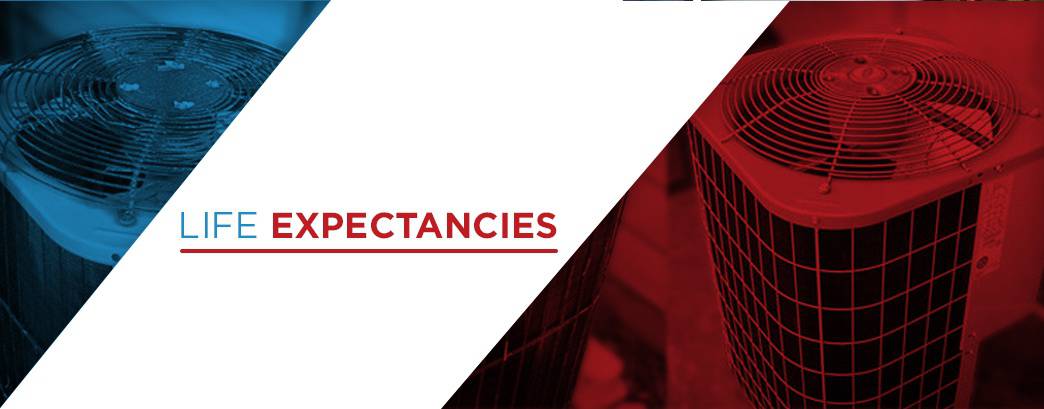
The lifespans of most HVAC systems range from 15 to 25 years, but this figure depends largely on the system type and how well it’s maintained.
- Natural Gas: If properly maintained, gas furnaces typically last for 20 to 30 years, sometimes even longer. Normally, the furnace is replaced when the heat exchanger starts to leak, as this component is one of the most important and expensive.
- LP Gas: Furnaces powered by propane tend to last for 18 to 20 years.
- Electric Heat Pump: Electric heat pumps last for a relatively long time, sometimes even 50 years. However, it is more common for them to cease functioning after 14 or 15 years. Despite this typically shorter lifespan, they are extremely steady and reliable heat sources.
- Geothermal: The indoor parts of geothermal systems last an average of 25 years, whereas the underground component can last for over 50.
- Oil: If properly maintained, an oil furnace can last for 15 to 20 years.
Maintenance Required

Of course, for these heating systems to reach their life expectancy, most of them require a certain amount of maintenance.
1. Maintenance for Natural Gas
When air is circulated in your home, dust and dirt particles accumulate on the filters. If this buildup becomes excessive, it may block the airflow, which will force your system to work harder to maintain the temperature, meaning that your system will have to use more energy.
To keep your natural gas furnace running efficiently, you can perform simple maintenance of the system by following these steps:
- Shut off the gas line. If performing maintenance, always turn off the furnace. The valve should be close to the gas meter.
- Examine the flames in the burner. If your system is functioning properly, the flame should be steady and blue. If the flame is orange or yellow, call a technician to find out if an unwanted gas is burning.
- Listen for unusual noises. If you hear any unusual noises or vibrations while the furnace is running, inform your technician and ask them for guidance.
- Sniff around for gas leaks. If you smell a gas leak, do not ignite any appliances or touch any electrical switches. Do not even use a phone. Go to a neighbor’s house and call a gas supplier immediately. Keep in mind that fuel gases do not always have a smell, and for this reason, carbon monoxide detectors are highly recommended.
It is also recommended that a professional technician inspect your system once a year before the cold weather kicks in. Technicians will determine the following things:
- The chimneys and vent connectors are unobstructed.
- The vent connector is in the correct position and slope and is not excessively corroded.
- The return air duct connection is in good condition and properly sealed to the furnace.
- The burner flames are well adjusted.
- The furnace’s physical support is in good condition.
- The vent and fresh air inlet are not obstructed.
2. Maintenance for LP Gas
Propane-fueled furnaces function in a similar way to natural gas-fueled furnaces, so refer to the section on natural gas furnace maintenance above.
3. Maintenance for Electric Heat Pumps
Electric heat pumps must also be taken care of to ensure proper functioning for many years. You can prolong the lifespan of your electric heat pump and save on energy costs by performing the following tasks:
- Don’t set the temperature below 65 degrees during the cold months.
- Don’t set it below 70 degrees during the hot season.
- In the wintertime, make sure there is no buildup of ice or snow on the pump.
- Change or clean the filters once per month or whenever it’s needed.
- Keep the unit outside clear from foliage and trim shrubs so they’re at least 18 inches away from the pump.
A professional technician should also perform maintenance on your unit once per year. They should check the following things:
- Cleaning the outdoor coils
- Obstruction of the ducts, blower, indoor coil and filters
- Leakage of the ducts
- Proper airflow
- Refrigerant leakage
- Proper refrigerant charge
- Electric terminals
- Proper electric control
- Proper thermostat functioning
4. Maintenance for Geothermal
You might think that maintenance would be an issue for any energy system that was buried underground. There are special considerations for repairs, but there’s no weather underground, so damage from the elements is minimal. Maintenance costs are often lower than for conventional systems.
Homeowners can keep their systems running efficiently by cleaning the filters according to the user manual and inspecting the condensate drain for clogging once every season.
However, because geothermal heating systems are closed systems and have refrigerants and other chemicals, the majority of maintenance should be done by a professional technician. The technician should check the tubes for leaks. Although these tubes do not usually need maintenance, leaks can occasionally form. The technician will perform tests to make sure the tubes are leak-free.
If a leak is detected, a repair will need to be done. Although rare, leaks in these coolant pipes can significantly affect your system’s performance.
Central PA Geothermal Maintenace
5. Maintenance for Oil

Maintenance of an oil-fueled furnace involves some simple tasks that can be done by the homeowner and other more complicated and risky tasks that should be left to a professional.
The homeowner can do the following things to ensure proper functioning of their system. Before performing any of these actions, consult your operator’s manual first.
- Look for soot and smoke. Check around your furnace for signs of black soot. If you see soot outside of your furnace, this may mean that something besides oil is burning. Inspect the smoke from your chimney as well while the unit is running — if the smoke is black, this may mean that the oil is being burned incompletely.
- Listen for unusual noises. If you hear any strange sounds, such as vibrations or rattling, coming from the blower of the furnace, contact a technician.
- Clean your system. Turn off the unit and the gas line. Once your furnace has cooled, remove the dust around the unit with a vacuum. For your safety, you should use a long hose attachment. By removing the dust, you can help cut down on the allergens in the air.
- Change the filter. Replace your air filter as often as your operator’s manual recommends. If you own pets, change it even more frequently.
The rest of the maintenance should be done by a dealer. The dealer will perform the following:
- Inspect the fan belt to make sure it’s tight, secure and has no fraying or cracks.
- Lubricate the fitting of the blower motors to reduce friction.
- Clean the nozzle of the blower to keep it from clogging and ensure that oil can easily go into the burner.
Call Home Climates for Your Free In-Home Estimate and Consultation
If you’d like to repair or upgrade your heating system to better handle the long, cold Pennsylvania winters, you’ve come to the right page. Home Climates can install a new unit for your home or maximize the performance of your existing system.
We provide a wide variety of heating services for Hershey, Lancaster, Harrisburg, Lititz, Mount Joy and Hummelstown. Contact us today to learn more. You can fill out our online form or call us at 717-689-4151.

